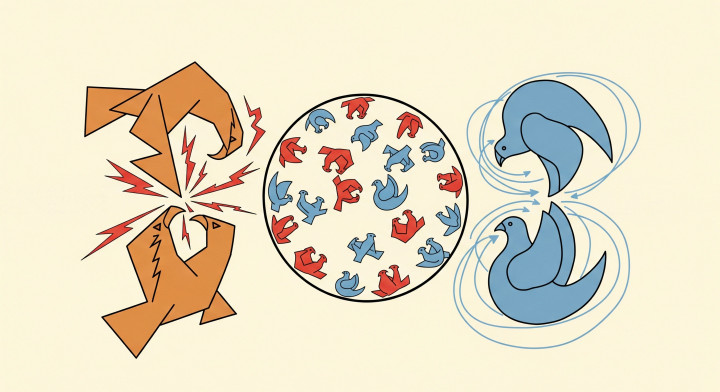Nature's Strategic Genius: Why Don't Stags Fight to the Death?
In the autumn forest, two massive red deer stags square off. They lock antlers, display their strength, and roar loudly. The fight is spectacular and brutal, yet in most cases, the weaker animal eventually gives up and retreats, leaving the victor to win the favor of the hinds. It's rare for these contests to end in death. But why? This doesn't seem to fit the classic image of "nature red in tooth and claw," a bloody struggle for survival. If the ultimate goal is to pass on one's genes, why doesn't the loser try to win at all costs, even risking its life?

Until the mid-20th century, this seemingly simple question was a serious puzzle for biologists. The naive answer—that animals hold back "for the good of the species"—proved scientifically untenable. Evolution operates at the level of individual success, not for some vague "common good." An individual that fought to the death and won would, in theory, be more successful at passing on its genes. So why didn't this killer strategy become more widespread?
The answer came from a British biologist named John Maynard Smith, who created an entirely new field of study: evolutionary game theory. His work forever changed how we view the evolution of behavior and introduced one of biology's most important concepts: the Evolutionarily Stable Strategy (ESS).
The Problem: Animals Don't Play Chess
Game theory was originally developed by economists and mathematicians to model the decisions of rational, calculating agents—people, companies, or countries—who consciously plan for the future. But animals aren't like that. A stag doesn't perform complex probability calculations before a fight. Its behavior is largely guided by genetically encoded instincts and strategies.
John Maynard Smith's brilliant insight was that the logic of game theory could be perfectly applied to evolution if you simply changed the terms:
- The players are not conscious individuals but members of a population.
- The strategies are not deliberate choices but genetically determined behaviors (e.g., "always fight," "always retreat").
- The payoff is not money but reproductive success, or fitness—a term that in this evolutionary context refers not to physical strength, but simply to the probability of passing on one's genes.
Within this framework, the central question becomes: which behavioral strategy can persist and spread in a population over the long term, especially when it's competing against other strategies?
The Solution: The Evolutionarily Stable Strategy (ESS)
Maynard Smith defined a strategy as evolutionarily stable if, in a population where almost everyone adopts it, no alternative (or "mutant") strategy can successfully invade.
Imagine a successful, established strategy as a king on a hilltop. An ESS is a "king" that can resist any small-scale rebellion. If a mutant individual with a different behavior appears in the population, it will simply perform worse than the others, and its offspring won't spread. An ESS is, therefore, an "invasion-proof" strategy.
The formal mathematical definition has two conditions:
- An ESS must do better against itself than any mutant strategy does against the ESS. (This is the straightforward case: the mutant is at an immediate disadvantage.)
- If a mutant happens to do just as well against the ESS as the ESS does against itself, then the ESS must do better against the mutant than the mutant does against itself. (This is a "tie-breaker" rule that prevents a neutral mutant from spreading by random drift.)
The Classic Example: The Hawk-Dove Game
To understand the logic of an ESS, let's look at Maynard Smith's most famous model: the Hawk-Dove game. Imagine a population where conflicts over a resource can be handled in one of two ways:
- Hawk: Always fights, aggressively and escalatingly. If it wins, it gets the prize. If it loses, it suffers a serious injury.
- Dove: Never fights. It only displays and postures. If its opponent attacks, it immediately flees, avoiding injury.
Let's analyze what would happen:
- A world of Doves: In a population of only Doves, conflicts are peaceful. Individuals posture, and the resource is often shared. It's a peaceful but vulnerable world. If a single Hawk mutant appears, it's paradise. It can intimidate every Dove without a fight and claim all the resources. The Hawk strategy would spread like wildfire. Therefore, a "pure Dove" strategy is not an ESS.
- A world of Hawks: In a population of only Hawks, every conflict results in a brutal fight. Winners take all, but losers are severely injured, drastically reducing their reproductive chances. If the cost of injury (C) is greater than the value of the prize (V), the average payoff for a Hawk is negative. Now, if a single Dove mutant appears in this bloody world, it will never fight, so it will never get injured. Although it loses every contest against a Hawk, its payoff of zero is still better than the Hawks' average negative payoff. The Dove strategy can successfully invade. Therefore, a "pure Hawk" strategy is not an ESS.
So, what is the solution? In this case, the ESS is not a pure strategy but a mixed strategy. The population settles into a stable state with a certain proportion of Hawks and Doves. This ratio is determined by the value of the prize and the cost of injury. At this equilibrium point, the average reproductive success of a Hawk is exactly equal to that of a Dove, so neither can outcompete the other.
This explains the behavior of the stags. Most species follow a mixed strategy where some conflicts involve only ritualized posturing (Dove-like behavior), and only certain situations escalate into genuinely dangerous combat (Hawk-like behavior).
Conclusion: The Logic of Behavioral Evolution
John Maynard Smith's work fundamentally changed biology. The concept of the ESS gave researchers a powerful mathematical tool to analyze the logic of behavior at the level of individual advantage. It replaced vague, group-selectionist explanations and showed that the stable behaviors we observe in nature—from aggression to altruism—are the result of an underlying strategic equilibrium.
Today, evolutionary game theory is not only used to study animal behavior but is also a fundamental tool in economics, sociology, and even cancer and virus research. It helps us understand that the "struggle for survival" is not always about the victory of the strongest or most aggressive. It is a complex, dynamic game where the most "invasion-proof," evolutionarily stable strategies are the ones that persist—creating the wonderful and sometimes baffling diversity of behavior we see in the natural world.





